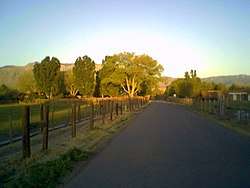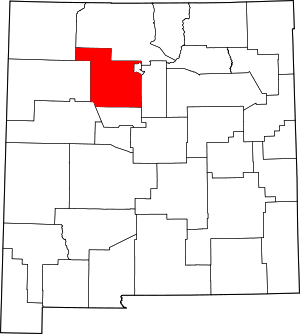Corrales, New Mexico
Corrales is a village in Sandoval County, New Mexico, United States. First farmed by Tiquex Pueblo people, chosen due to its proximity to the Rio Grande, as documented by Hispano farmers of Nuevo México in the late 1500s. Despite being a part of the Albuquerque metropolitan area, the village maintains its rural character, while also being surrounded by the cities of Albuquerque and Rio Rancho.[2] The population of Corrales was 8,329 at the 2010 Census.
Corrales, New Mexico | |
|---|---|
 Mariquita Road in Corrales | |
 Location of Corrales, New Mexico | |
 Corrales, New Mexico Location in the United States | |
| Coordinates: 35°14′5″N 106°37′5″W | |
| Country | United States |
| State | New Mexico |
| Counties | Sandoval |
| Government | |
| • mayor | Jo Anne Roake |
| Area | |
| • Total | 11.3 sq mi (29 km2) |
| • Land | 10.7 sq mi (28 km2) |
| • Water | 0.5 sq mi (1.3 km2) |
| Elevation | 5,023 ft (1,531 m) |
| Population (2010) | |
| • Total | 8,329 |
| • Estimate (2018)[1] | 8,678 |
| • Density | 740/sq mi (290/km2) |
| Time zone | UTC−7 (Mountain (MST)) |
| • Summer (DST) | UTC−6 (MDT) |
| ZIP code | 87048 |
| Area code(s) | 505 |
| FIPS code | 35-17960 |
| GNIS feature ID | 0905378 |
| Website | corrales-nm.org |
The Rio Grande Bosque on the eastern edge of the village provides refuge for native animals and plants, and ancient Pueblo and Hispano acequias continue to be maintained by the United States Department of Agriculture's Natural Resources Conservation Service and the Middle Rio Grande Conservancy District.[3]
History
The village of Corrales (Spanish for "corrals") is located along the Rio Grande river and is built on the site of two Indian Pueblos settled before AD 500 by the Tiguex Indians, and which were later occupied by Spanish Colonists and explorers who colonized the region around 1540. The pueblo indians who lived in the area abandoned it by the late 1600s when the Spanish settled permanently in New Mexico. The Spanish Colonists subsequently built an adobe church on the site called the Church of San Ysidro in 1868, named after the annual fiesta de San Ysidro in May.
In 1710, a grant of the Alameda lands (including Corrales) was given to Corporal Francisco Montes Vigil, A soldier in the Spanish army. Vigil sold it in 1712 to Captain Juan Gonzáles Bas who was then living in Bernalillo. Gonzáles subsequently sold the land comprising the Village of Corrales in 1718 to Salvador Martinez. Over time, the land comprising the Village of Corrales was parceled off and sold for agricultural development and livestock ranching. The current Village of Corrales government was incorporated and chartered in 1971.[4]
The village was selected as #19 in CNN Money's list of the 100 best places to live in 2007.[5]
Geography
Corrales is located at 35°14′5″N 106°37′5″W (35.234838, −106.618183).[6]
According to the United States Census Bureau, the village has a total area of 11.2 square miles (29 km2), of which, 10.7 square miles (28 km2) is land and 0.5 square miles (1.3 km2) (4.71%) is water.
Until 2005, portions of the Village of Corrales were located in both Bernalillo and Sandoval counties. In 2005, a special election annexed the portion of Corrales located in Bernalillo County to Sandoval County, so that now the entire village is located in Sandoval County.
Demographics
| Historical population | |||
|---|---|---|---|
| Census | Pop. | %± | |
| 1980 | 2,791 | — | |
| 1990 | 5,453 | 95.4% | |
| 2000 | 7,334 | 34.5% | |
| 2010 | 8,329 | 13.6% | |
| Est. 2018 | 8,678 | [1] | 4.2% |
| U.S. Decennial Census[7] | |||
Corrales is part of the Albuquerque Metropolitan Statistical Area.
As of the census[8] of 2000, there were 7,334 people, 2,819 households, and 2,122 families residing in the village. The population density was 683.7 inhabitants per square mile (264.0/km2). There were 2,983 housing units at an average density of 278.1 per square mile (107.4/km2). The racial makeup of the village was 86.05% White, 0.57% African American, 1.51% Native American, 0.79% Asian, 0.03% Pacific Islander, 8.22% from other races, and 2.82% from two or more races. Hispanic or Latino of any race were 25.55% of the population.
There were 2,819 households out of which 32.5% had children under the age of 18 living with them, 65.4% were married couples living together, 7.1% had a female householder with no husband present, and 24.7% were non-families. 18.1% of all households were made up of individuals and 4.7% had someone living alone who was 65 years of age or older. The average household size was 2.60 and the average family size was 2.97.
In the village, the population was spread out with 24.6% under the age of 18, 4.8% from 18 to 24, 25.9% from 25 to 44, 34.2% from 45 to 64, and 10.5% who were 65 years of age or older. The median age was 42 years. For every 100 females, there were 93.5 males. For every 100 females age 18 and over, there were 90.2 males.
The median income for a household in the village was $67,217, and the median income for a family was $79,331. Males had a median income of $52,397 versus $34,091 for females. The per capita income for the village was $33,629. About 3.1% of families and 5.0% of the population were below the poverty line, including 7.8% of those under age 18 and 1.8% of those age 65 or over.
Village infrastructure
Unlike the surrounding communities of Rio Rancho and Albuquerque, the Village of Corrales does not have a centralized water system for running water or a municipal sewage system, which requires homes and businesses to each install their own wells and water pumping systems and leach fields for sewage disposal. Newer homes built in Corrales are no longer allowed to install leach fields and are required to use closed septic systems with a holding tank which must be pumped regularly by sewage trucks at the homeowner's expense. The Village has an extensive system of canals which transport water from the Rio Grande river to crop fields and pasturage for crop irrigation and livestock. The Village is heavily wooded with large stands of cottonwood and other native trees. Russian olive trees grow throughout the area and are an invasive species.[9][10]
Notable people
Corrales is the residence of former U.S. Senator Fred Harris of Oklahoma, who unsuccessfully sought the 1976 Democratic presidential nomination.[11] Timothy Kraft, a political consultant and campaign manager for Harris' rival, Jimmy Carter, formerly lived in Corrales.[12]
Actor Jace Norman was born in Corrales on March 21, 2000.
References
- "Population and Housing Unit Estimates". Retrieved August 25, 2019.
- "Village of Corrales, New Mexico". Retrieved 2012-03-30.
- "EQIP Acequia Initiative - NRCS New Mexico". NRCS. Retrieved March 5, 2020.
- "Corrales, New Mexico". www.corrales-village-website.com.
- Ashford, Kate; Bartz, Andrea; Cox, Jeff; Fitch, Asa; Gandel, Stephen; Hyatt, Josh; Kelley, Rob; Knight, Kathleen; et al. "CNN Money Magazine 100 Best Places to Live 2007, Corrales".
- "US Gazetteer files: 2010, 2000, and 1990". United States Census Bureau. 2011-02-12. Retrieved 2011-04-23.
- "Census of Population and Housing". Census.gov. Retrieved June 4, 2015.
- "U.S. Census website". United States Census Bureau. Retrieved 2008-01-31.
- "Planning and Zoning".
- "Municode Library". library.municode.com.
- Berg, Jeff (March 2008). "The Political Kraft". Desert Exposure. Archived from the original on 2013-12-28. Retrieved 2013-07-02.
- Kaufman, Burton Ira (2009). The Carter Years. Facts on File library of American History: Presidential Profiles. New York City: InfoBase Publishing. p. 271. ISBN 9780816074587.

